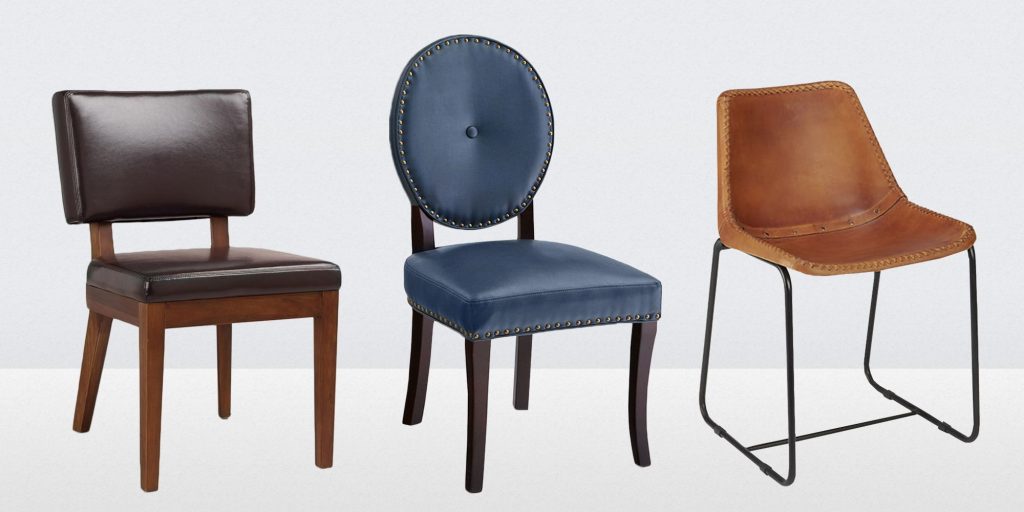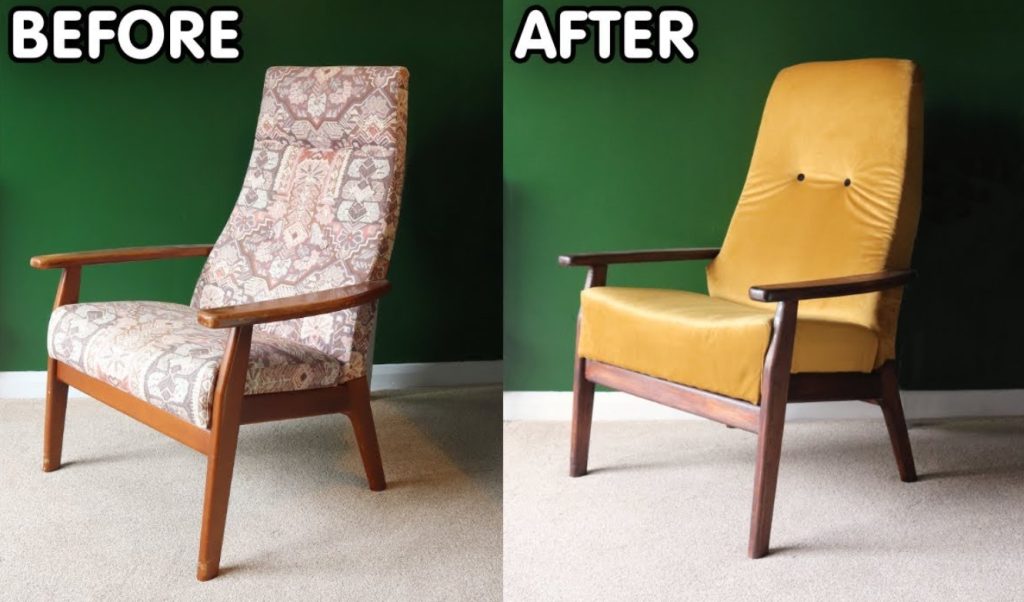Furniture made of leather is stylish, cozy, and pricey. However, you shouldn’t throw your chair in the trash when the leather becomes cracked, dry, or brittle.
Replace the chair’s old upholstery with a new one to preserve it instead of removing the previous one. Since most leather chairs have solid frames, this contributes to the chair’s durability, comfort, and overall quality.
In this article, we will tell you how to reupholster a chair with leather. With no further ado, let’s get started!

How to Reupholster a Chair with Leather
Gather the equipment you will need to upholster your chosen chair. Most of the equipment is readily available at home, although some may require a purchase. Here are the tools you will need for the simplest process when reupholstering your furniture:
- Leather fabric
- Cushion or padding (for chairs)
- Tacks
- Tack hammer
- Staples
- Staple gun
- Leather shears
- Heat gun
- Tack puller.
You can substitute some of these things if you don’t have them. You can utilize these products in place of the necessary specialized tools for the project.
- Heat guns are replaced by hairdryers
- Use a box knife or scissors in place of leather sheers
- Instead of a tack hammer, use a standard hammer
- Instead of a tack puller, use a standard hammer
You will also need staples if you do not already have a staple gun. If you don’t have these tools, your upholstery won’t be secure enough. This tool is simple to use and available for purchase or rental at many retailers. When using power tools, be sure to use all necessary caution.
Pick your fabric
When upholstering your furniture, there are many different varieties of leather from which to pick. You’ll consider what you need and what color will look best in your chosen location.
Many novices are unaware that numerous leather varieties originate from various animal breeds. When choosing leather, you have several options to consider:
- Corrected grain leather
- Faux leather
- Aniline leather
- Semi-aniline leather
- Pigmented leather.
Take old material out
You must first remove any old material before you can begin applying the new material. The previous cushioning is part of this substance. Any old padding should be avoided since it could cause damage or harbor harmful microorganisms.
Remove every staple from the seat or the wood. If there is any leftover material, the new staples may not adhere properly, and the leather may bulk up there.
Measure the furniture’s size
Measure the furniture so that you know how big to make the leather cuts. Always make a larger cut than a smaller one. If the cloth is too large, it will be trimmed away; nevertheless, no material will be added if it is too little.
Any of these measurements should be recorded in writing. Even if your memory is at its sharpest, some figures can still be missed, necessitating another round of measurements. Making the cuts and recording the measures is the best procedure.
Cutting the fabric
Using leather sheers can make cutting fabric simple. If you cut with standard scissors that aren’t extremely sharp, the edges could be rough and disorganized. The best option is leather shears because they are sturdy and sharp enough for heavier fabric.
You won’t have to worry about the edges when you cut a larger area than the measured area. Later, when you want to tidy it up, you can trim this. So, as long as you have scissors, you can get by with this. It’s okay if the edges are disorganized because they won’t be visible.

Insert the padding
Before wrapping the fabric around the furniture you are reupholstering, carefully cut and attach the padding as a cushion to the seat. There is typically a cushion where people sit with this furniture style, though you are not required to add cushioning if you like.
The cushion on many chairs is made of foam around 2 inches thick. You can use a 3-inch cushion, but many chairs with this thick cushion have a stitched seat, making installation a little trickier than with a 2-inch cushion.
Flip the seat over onto the cloth you have cut out after measuring and positioning the cushion on top of the furniture. It is ideal for the material to be larger than the seat. If not, your cloth isn’t big enough to completely round the seat.
Protect the leather
The top side of your seat has now been placed on the leather. The enjoyable part will be this phase. Tack the leather to the bottom after pulling it over the sides. To ensure that there is no slack, pull them tightly.
Securing the leather is rather labor-intensive, and you must take several actions to finish it. You will be performing the following throughout this stage of the reupholstery procedure:
Tack the leather
Your tacks are transitory; they don’t need to be close like staples. A few inches should separate each tack. If the tracks aren’t holding the leather, bring them closer.
Staple it
When stapling the leather, do so closer as when placing tacks. Start in front and move to each side. Apply the staples first all around your seats. Remove the tacks after those are in place and replace them with staples. Always secure the straight portions of the space before moving on to the corners.
Work the corners
One of the more challenging steps you will encounter is this one. If you’re starting, you could feel frustrated, but don’t worry. Even though it can take a little longer, you can easily complete these corners if you have a little patience and learn the best technique. These are some ways to work the corners:
Heat up the corners
You can fit more snugly on the seat by heating the corners of the upholstery. This causes the leather to stretch. You will need the heat gun for this step. You can always use a hairdryer if you don’t have a heat gun. Make sure the hairdryer is set to high heat before using it.
Tightly pull the corner
Make sure there is no slack by pulling the corners securely. The creases will spread to the seat’s bottom as you pull. As long as the top side appears tidy and taut, it is acceptable to have a small bit of fabric muck at the base of the seat.
Both sides of the corner should be stapled
The next step is to pleat the fabric, which involves folding it inside of itself. This makes it simple to clip the excess material after you’ve secured the staple. Lay a staple on either side of each fold as you finish it. After finishing, cut your fabric.
Examine the slack
Turn the seat over after you have stapled everything in place. You will inspect the corners and the seat for any slack. Look for any lumps, creases, or rolls at this time. None of them should be in the center of your cushion. Depending on your preferences, you might have a few at the corners, but this might be okay.
If there is any extra slack, you should eliminate it. Although it may seem difficult, you must keep it taut for the seat to endure longer because it will eventually become loose.
Get rid of extra material
It will be easy sailing from here on out once you have taken care of all the slack in your furniture. Trimming any surplus leather cloth is the first step. Extra flaps that can be removed easily shouldn’t hang from your seat.
Trim close to the seat, but not so close that the staples could cause the fabric to rip. Although it doesn’t have to be flawless, the cutting shouldn’t be too bulky. You want to avoid having too many lumps and bumps as the bottom will be covered with plain cloth.
Add long staples and a bas cover
Add a couple of long staples to the seat base before adding the cover for added security. You may offer more support and protection by utilizing lengthy staples. These work best when used in larger spaces. The lengthy staples can be used to push these locations down.
You are essentially in the simple stages of the reupholstery at this point. The remaining base will be covered with a non-woven material frequently used in gardens to prevent weed growth. Here are the steps to do that:
- Measure the fabric.
- Trim the sides.
- Secure the fabric.
You Might Be Interested: How to Reupholster a Couch Without Removing Old Fabric
Conclusion
This is it! This was the guide on how to reupholster a chair with leather. That essentially covers the fundamentals of reupholstering an old chair.
Because each chair is unique, there will be several obstacles in your chairs. You should be alright as long as you remember to write down the procedures and the order in which you remove the parts.